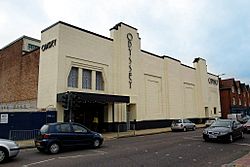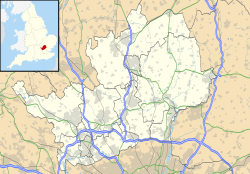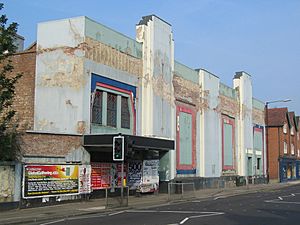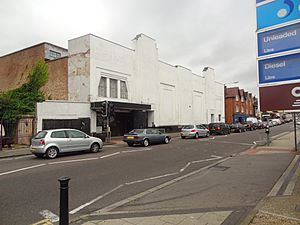Odyssey Cinema, St Albans facts for kids

The Odyssey Cinema
|
|
| Former names |
|
|---|---|
| Address | London Road St Albans England, UK |
| Coordinates | 51°44′53″N 0°19′57″W / 51.7479352°N 0.3325751°W |
| Public transit | St Albans City |
| Owner | Private investors |
| Designation | Locally listed building |
| Type | Independent cinema |
| Capacity | 500 (previously 1,728) |
| Construction | |
| Opened | 1908 |
| Closed | 1995 |
| Reopened | 2014 |
| Rebuilt | 1931 |
| Years active | 1908–1995; 2010–present |
| Architect | Percival Blow, James Martin Hatfield, Kemp & Tasker |
The Odyssey Cinema is a cool movie theater in St Albans, England. It's a special building with an Art Deco style. This means it has a unique, decorative look from the 1920s and 30s. The cinema is located on London Road, not far from St Albans Cathedral.
The building you see today was built in 1931. It stands where an even older movie theater, called the Alpha Picture Palace, used to be. The Alpha Picture Palace was very important because it opened in 1904. It was started by a film pioneer named Arthur Melbourne-Cooper. Many people think it was the very first cinema in Hertfordshire!
Contents
History of the Odyssey Cinema
The Early Days: Alpha Picture Palace
Arthur Melbourne-Cooper was born in St Albans in 1874. When he was a teenager, he met Birt Acres, who inspired him to get into making moving pictures. Cooper became a famous early filmmaker.
In 1906, Cooper started his Alpha Trading Company. He made short films, cartoons, and newsreels. He filmed many pioneering movies in St Albans, like the animated fantasy Dreams of Toyland (1908).
Cooper wanted a place to show his films to people. He bought a public hall on London Road. This building was designed in 1903 by local architect Percival Blow. On July 27, 1908, Cooper opened the Alpha Picture House. It was Hertfordshire's first permanent cinema.
The building had a restaurant, a swimming pool, and a hair salon, as well as the 800-seat cinema. After a new law about cinemas in 1910, the building failed an inspection. Cooper sold it in 1911.
New Beginnings: Poly and Regent
After Cooper sold the cinema, it changed owners and names many times. In 1918, it became the Poly Picture Palace. In 1923, Percival Blow updated the cinema again. He added a balcony with special viewing boxes and a cinema organ. There was also a dance hall in the basement.
From 1926, the cinema was known as The Regent Picture House. But on December 15, 1927, a big fire destroyed The Regent. It was caused by a dropped cigarette.
The Capitol Cinema
After the fire, plans were made for a new cinema. Percival Blow and James Martin Hatfield designed the new building. It had 1,620 seats, a large stage, a special Compton theatre organ, a café, and dressing rooms. Because the land sloped, people entered the cinema at the balcony level. Then they walked down to the main seating area.
The new cinema was called The Capitol Cinema. It opened to the public on December 3, 1931. In 1932, The Capitol was sold to the D.J. James Cinema Circuit. In 1934, the cinema was made even bigger by the architects Kemp & Tasker. It could then hold 1,728 people.
The cinema changed hands again in 1937. It became part of Eastern Cinemas. Then, in 1943, it was taken over by the Rank Organisation. They changed its name to The Odeon on January 1, 1945.
On October 30, 1963, famous music groups like The Rolling Stones and The Everly Brothers performed at the cinema. Even though television became popular in the 1950s and 60s, the St Albans Odeon kept doing well. It showed new Cinemascope films to attract audiences.
In the 1970s, fewer people went to the cinema. So, in 1973, the Odeon was divided into three smaller screens. It reopened on January 21 with a showing of A Clockwork Orange in one of the new screens.
Closure of the Odeon
By the 1990s, big cinema companies started building large movie theaters outside of towns. They began selling their smaller town cinemas. When a new cinema opened in Hemel Hempstead in 1995, Rank decided to close the St Albans Odeon.
Local people tried to save the cinema, but it closed on August 20, 1995. The last film shown was Waterworld. After it closed, everything inside the building was removed.
Re-opening as The Odyssey
The building was empty and unused for many years. A company bought it and wanted to knock it down to build apartments. A local group tried to save the cinema, but the St Albans City Council voted to demolish it. One council member even said that "nobody wanted it back as a cinema."
However, in November 2009, a local businessman named James Hannaway bought the old cinema. He had help from local fundraisers, including school children. Hannaway planned to fix up the building and reopen it as a cinema. He had already helped reopen another historic Art Deco cinema called The Rex, Berkhamsted.
A new fundraising effort began to restore the cinema to its original 1930s look. A public competition was held to choose a new name. The name The Odyssey was chosen. It was named after the movie 2001: A Space Odyssey, to honor the director Stanley Kubrick, who had family connections to St Albans.
Restoration work started in 2013. The cinema reopened to the public on November 30, 2014. It is now an independent, single-screen cinema that shows special films. It has 500 seats, a café, and a bar.
Architecture
The Odyssey Cinema building is famous for its beautiful Art Deco style. This style was popular in the 1920s and 1930s. It features geometric shapes, bold lines, and decorative details.




